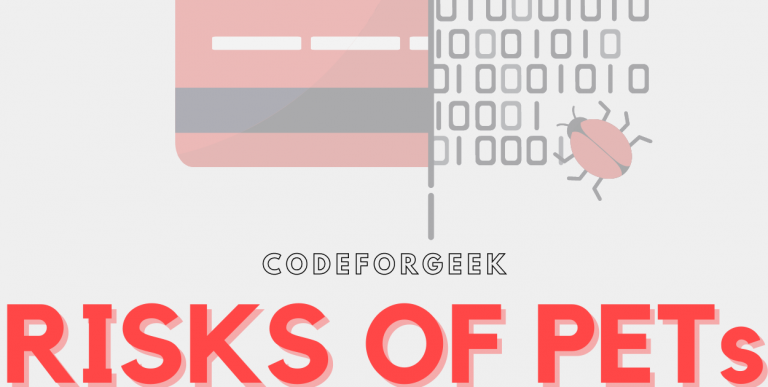Risks of PETs (Privacy Enhancing Technologies)? Well, reading the title you might wonder what could ever go wrong with “privacy-enhancing technologies”. Aren’t they made to safeguard information and enhance privacy? Well, the answer is – there do exist risks with such technologies.
The last time I talked about PETs or privacy-enhancing technologies, we mentioned what they are, how they work, their objectives, and many other things. Well, as I mentioned in that prequel, that I will be discussing the risks of PETs in a fresh blog. So here it is, as promised!
Read the prequel – “Privacy Enhancing Technologies – A Smooth Guide”.
Security and privacy are crucial subjects today for not just individuals but also enterprises, businesses are it small, medium, or large, governments, and everyone and everything online! Data has become so crucial today people have taken unbelievable measures to protect it.
As I was saying, with the proliferating demand for security and privacy online, the world is simultaneously showing a great demand for privacy-enhancing technologies or PETs. The already existing ones have already been a great success.
However, there surprisingly are many risks of PETs that we are interested in today. In this article, I will give a brief walkthrough on what privacy-enhancing technologies or PETs are, how they work, and the risks of PETs.
Although I did explain what PETs are in the prequel of this post, I will still cover it in this guide so you can get a better understanding of the risks of PETs.
What are Privacy Enhancing Technologies?
PETs or privacy-enhancing technologies, as the name suggests, are like an all-encompassing term for technologies that basically aim to bolster and enhance the privacy and security of data while it is in use.
Though most privacy-enhancing technologies have great similarities, they are customizable based on the use cases they function in.
A proper and exact definition of PETs is difficult to come up with. It is majorly because there are multiple insinuations associated with them. PETs aren’t new arrivals in the world of technology. They’ve been around for more than 30 years now and have found newer, effective, and gainful use-cases.
How do Privacy Enhancing Technologies (PETs) Work?
When “enhancing privacy” or protecting data while in use, privacy-enhancing technologies undertake basically three procedures.
- Firstly, these technologies greatly rely on a trustworthy environment that can be used for analysis and processing of highly sensitive data.
- Secondly, to avoid most risks of PETs, the task processing and analysis are conducted in a decentralized manner.
- Lastly, the data and algorithms are encrypted by PETs before executing the analytics or processing tasks. This process is considered the highly crucial part which helps in controlling several risks.
Now that we got an idea of what PETs are and how they work, lets us move on to understanding the risks of PETs.
Risks of PETs: Revealing the Dark Secrets
It is important to understand the risks of PETs because they have many profound pitfalls even though they are made to counter problems. Let us get started.
Difficulty & Complexity of Usage
The very first setback of privacy-enhancing technologies is the difficulty they pose while using them. This complexity of usage can result in errors for users.
#1 Higher Costs
Privacy-enhancing technologies are costlier to set up and use. They require large computational power to use them. Usually, switching to these powerful computational resources is again costlier and infeasible for businesses that aim to reduce costs.
#2 Harmful to the Environment
The major one from the list of risks of PETs is that they are harmful to the environment. This is because they have an immense amount of energy consumption which is derived from high-level computational resources which in turn is detrimental to the environment.
#3 Lack of Regulations
It is difficult to formulate appropriate and accurate regulations for PETs as it is difficult to restrict their resources. Policymakers also face difficulties when it comes to establishing proper auditing and laying appropriate judicial precedents.
#4 Require Specialized Knowledgebase
These tools require specialized knowledge or skills to operate as they are too complex for individuals. Average consumers of these technologies might not be as skilled and hence, they would require specialized personnel to operate them and it can eventually fail.
#5 Lack of Incentives
These technologies have high competition among themselves and are greatly lacking ideas. Moreover, the current economic scenarios are not in favor to give developers incentives to deploy these tools and hence newer tools lack unique features or changes; this is eventually discouraging these developers.
Conclusion
Security and privacy are crucial subjects today for not just individuals but also enterprises, businesses are it small, medium, or large, governments, and everyone and everything online.
The last time I talked about PETs or privacy-enhancing technologies, we mentioned what they are, how they work, their objectives, and many other things. Well, as I mentioned in that prequel, that I will be discussing the risks of PETs in a fresh blog.





